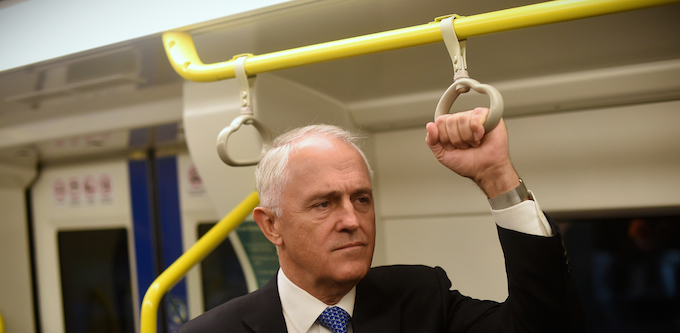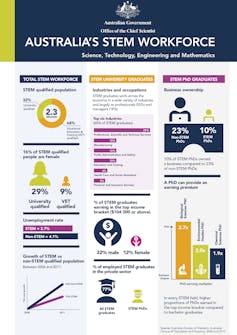
By Sean Gallagher, Beth Webster and Sarah Maddison, Swinburne University of Technology
In 2015, Prime Minister Malcolm Turnbull welcomed us to the “ideas boom”, launching a National Innovation and Science Agenda to “drive smart ideas that create business growth, local jobs and global success”.
In January 2018 the specially-created independent statutory board Innovation and Science Australia (ISA) released its report Australia 2030: Prosperity through Innovation. It’s a document that has been described not as a roadmap for action, but “more of a sketch with detours, dead ends, and red lights which should be green”.
The federal government’s May 2018 response to this report adds further disappointment. The response fails to seize the opportunity to deliver a properly funded and connected education, research and innovation system.
Australia is left with a series of well-meaning but disparate programs that only get us part way to ensuing that Australia thrives in the global innovation race.
Action is required
Today, we sit at the dawn of the fourth industrial revolution where virtual, physical and biological worlds are merging. Sophisticated cognitive and automation technologies will transform our world in ways difficult to imagine. These technologies are increasingly able to perform human tasks better, faster, and more cheaply.

Office of the Chief Scientist
But it is the emergence of vast, expanding digital platforms and the ecosystems they support that will have a more profound impact on the future of work. Their ever-increasing complexity and accelerating change means constant disruption is the new business as usual.
If we are to respond to the changing nature of future work, we need to build a world-beating national innovation ecosystem, especially by equipping Australians with skills and experience relevant to 2030. As we transition into the digital economy, that means technical, digital and STEM skills are vital. (STEM refers to science, technology, engineering and maths.)
Growth in STEM jobs is 1.5 times that of non-STEM since 2005, yet we continue to produce non-STEM graduates at higher rates than those in STEM. The performance of our kids at school — particularly in maths and science — has declined against international benchmarks.
Clearly, strategic intervention is needed: this is where ISA should come in.
Nothing new on education
The ISA report recommendations on education cover:
- better training for teachers, particularly STEM teachers;
- preparing students for STEM degrees and jobs;
- improving student achievement in literacy and numeracy;
- interventions to reduce educational inequality; and
- improving our vocational education and training (VET) system.
Yet none of these education recommendations were directly supported by the government: only “in principle” or “noted” support was offered in the response document.
While school education in Australia is the constitutional responsibility of the states and territories, the Australian government never shies away from using the funding carrot to leverage school policy outcomes for the betterment of the country.
For instance, full marks go to the federal government supporting STEM education through the Education Council’s National STEM School Education Strategy 2016-2026, and for funding several excellent STEM education projects and initiatives. So why not fund increased numbers and quality of STEM teachers?
Likewise, the urgent need to support the Vocational Education and Training (VET) sector to help it drive innovation, automation and new technologies, and provide businesses with requisite skills training is absent. The Skilling Australians Fund — the government’s main VET policy instrument and a welcome apprenticeship initiative — does little to transition the existing workforce through VET.
Funding for R&D is unclear
Turning to research and development (R&D), the government supports the ISA recommendation to enhance AI and machine learning capabilities — absolutely essential in the digital economy. However, there was no additional funding in the 2018 federal budget beyond existing digital technologies program.
At face value, the raft of funding commitments in the budget for R&D looks promising. But are the funds in addition to existing commitments, or a re-labelling of existing funds?
A persistent criticism from industry of government support is the continual chopping and changing of policies and programs, both in name and content.
ISA recommended extending export support programs, which is sensible given the solid evidence that they work. However, in its response the government merely said they are supported in principle, with no further funds forthcoming.
What about the future of work?
Agile approaches, exponential organisations, freelance economy, and Industry 4.0 are rewriting the rules of how economic value is created.
The ISA report aims to provide comfort about how to create employment opportunities towards 2030, but it speaks more to the past than to the future. Knowledge work — a main focus of the report — will increasingly be performed less by people and more by machines, creating vast workforce transformation challenges for industry.
The closer we get to 2030, the less the ISA view of the future will be true. Emerging evidence already contraindicates this view.
For work done by people, data from the United States and Australia already show enormous growth of freelancers, including operating from co-working spaces. Modelling suggests this trend will continue.
In parallel, business are becoming more agile. ANZ is completely restructuring itself to look more like 150 startups, and downsizing in the process. NAB is sacking 6,000 staff — including many knowledge workers — and replacing them with 2000 technology specialists and digital workers. All large companies are expected to follow.
Dissociating ‘work’ from ‘jobs’
In the emerging freelance economy, work is increasingly being dissociated from jobs on digital platforms like Upwork. And as more companies go agile, they will have fewer employees but have a larger workforce, leveraging the freelance economy through these platforms.
The upshot? People will increasingly need to create their own work opportunities rather than expect to get a traditional job.
Developing digital skills is essential, and the ISA report rightly focuses on them. But in the highly disruptive and dynamic environment of digital platforms, the core worker skill set will be competent risk taking. Diversity of experience combined with continuous learning are essential ingredients.
Alongside investments in teaching, we should be investing in opportunities where students — from secondary to tertiary education — can “learn-by-doing” in emerging futures of work.
It is for others to discuss the merits of whether these disruptive changes to the economy and employment should be allowed happen or not. But New York Times columnist Tom Friedman sums up the certainty of the approaching tech disruption perfectly:
“Whatever can be done, will be done. The only question is, “Will it be done by you or to you?” but it will be done.”
The inexorable and exponential rise of sophisticated technologies in the digital economy — the Australian economy — will impact all work and change all jobs. We need to be investing in this future for our children.
![]() And we need the government to support and fund a well-integrated innovation ecosystem to incorporates education, research, industry and government.
And we need the government to support and fund a well-integrated innovation ecosystem to incorporates education, research, industry and government.
This article was originally published on The Conversation. Read the original article.
NOW READ: Budget 2018 was all talk on innovation, but funding falls short


COMMENTS
SmartCompany is committed to hosting lively discussions. Help us keep the conversation useful, interesting and welcoming. We aim to publish comments quickly in the interest of promoting robust conversation, but we’re a small team and we deploy filters to protect against legal risk. Occasionally your comment may be held up while it is being reviewed, but we’re working as fast as we can to keep the conversation rolling.
The SmartCompany comment section is members-only content. Please subscribe to leave a comment.
The SmartCompany comment section is members-only content. Please login to leave a comment.